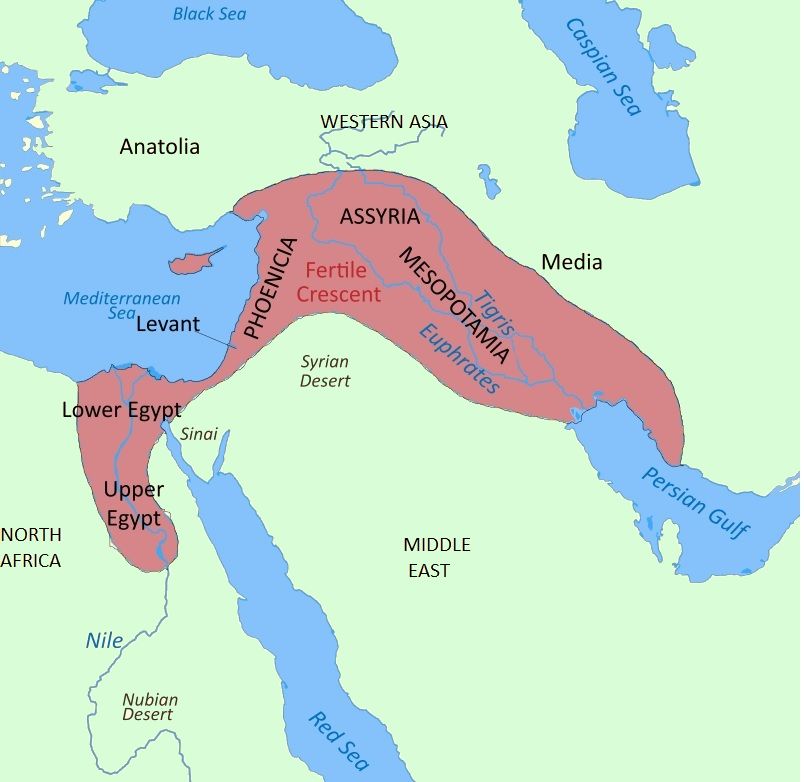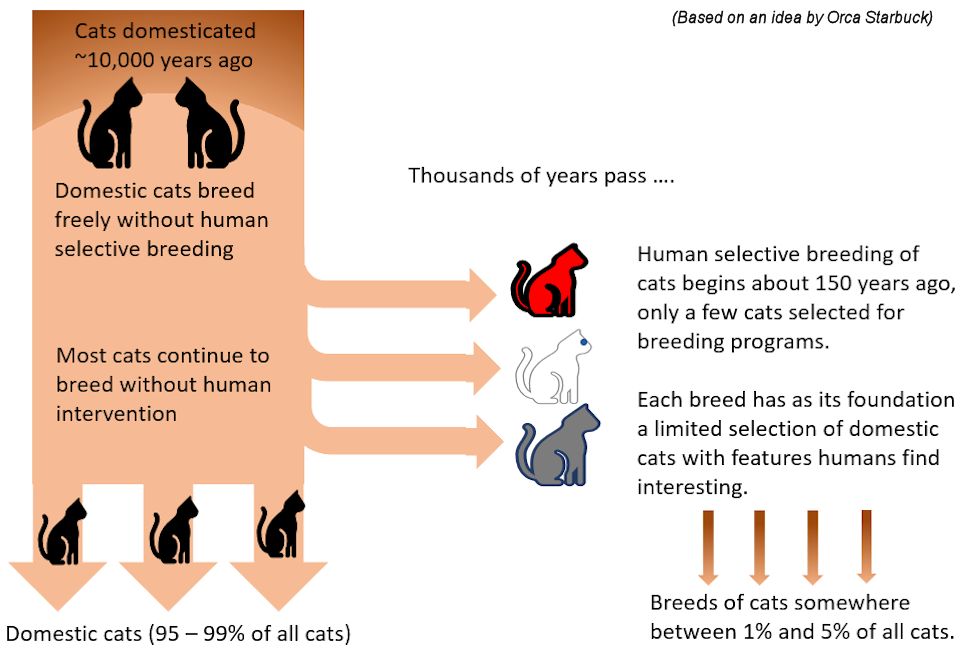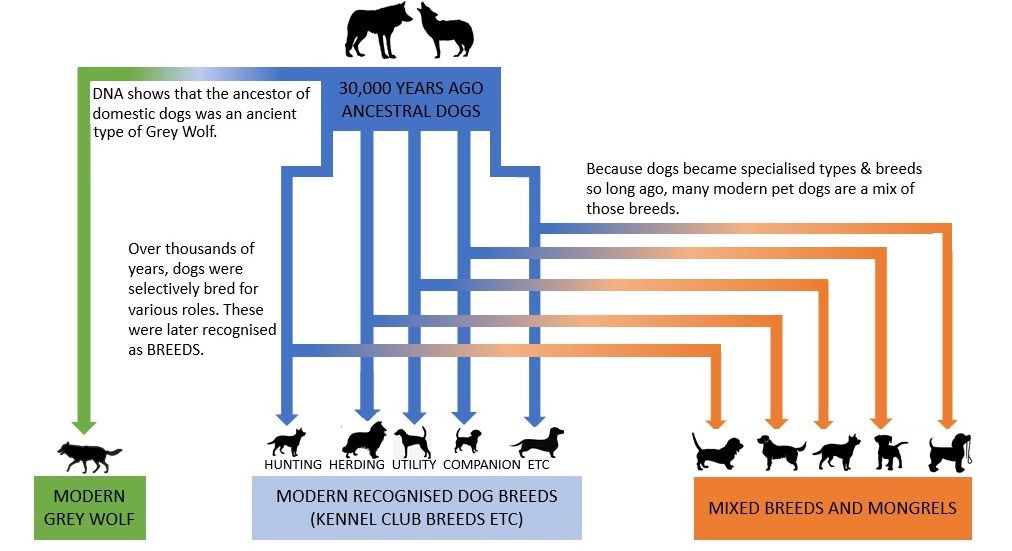
PEDIGREE, PUREBRED, MIXED BREED, RANDOM-BRED Ė WHATíS THE DIFFERENCE?
I get many emails with photos asking "what breed is my cat" or "what mix of breeds is my cat." Unless your cat came with a pedigree from the breeder it is considered a Domestic Shorthair, Domestic Longhair or Domestic Semi-Longhair. Some breed cats do end up at shelters, and are recognisably Persian, Siamese etc in conformation as well as colour, but not every long-haired cat has Persian ancestry, not every colourpointed shorthair cat is part-Siamese and not every tailless or rabbit-tailed cat is a Manx.
WHAT IS A PEDIGREE?
A pedigree is a certificate showing the cats ancestors over 3 or more generations (usually 3 to 5). A pedigree certificate can be registered with a reputable cat organisation such as TICA, GCCF, CFA, WCF, FIFe etc depending on which country you are in. Online registries Ė known as paper registries Ė exist for unrecognised varieties, but their breeds and pedigrees are not recognised by the main organisations. The pedigree must come from a major registry that organises championship shows.
A pedigree is a family tree that can be certified as correct by one of the main cat registries - this is what makes a cat a "pedigree cat." A pedigree cat may even have several breeds in its ancestry e.g. Himalayan (aka Colourpoint Persian outside of the USA) and Persian and Exotic Shorthair because these are related breeds.
If a pedigree is just a piece of paper, what is a purebred? Purebred means that the catís ancestors are all the same breed, whether or not it has a registered pedigree. A breeder who tells you his/her pedigree Siamese are purebred seal-point Siamese means the cats have nothing except seal-point Siamese ancestors in the 3 Ė 5 generation pedigree. Purebred is not particularly meaningful as it is the pedigree certificate that counts.
MIXED BREED OR RANDOMBRED?
If your cat isnít a pedigree cat, what is it? What is the difference between "mixed breed" and "random bred"? Many people have the misconception that non-pedigree cats are "mixed breed" in the same way as non-pedigree dogs. To be mixed breed, the ancestors must be identifiable breeds. Because only a low percentage of the cat population are breed cats (i.e. pedigree cats registered as being a particular breed), it is unlikely that your non-pedigree cat has a breed cat in its background unless you acquired it from someone who owns its registered pedigree parent and can show you the pedigree as evidence. Sadly, some of these are backyard breeders.
"But dogs are mixed breed!" you might say. This is the big difference between the domestication and organised breeding of dogs and the organised breeding of cats. Dogs were domesticated about 30,000 years ago and selectively bred for various roles for thousands of years. Their physical characteristics and behaviour are related to their role: hunting, herding, protection, fighting, vermin-killing, companions etc. Some are tiny, some are massive, some have modified features (sometimes grotesquely exaggerated by the modern dog fancy.) Over thousands of years, those characteristics have become so fixed that many mixed-breed dogs show traits of their working ancestors. The different types became "purebred" well before the invention of pedigree certificates.

Cats became domesticated much later when they were attracted to granaries in the fertile crescent. The granaries attracted hungry mice and the mice attracted hungry cats, and the cats went about their business with no intervention from humans. They werenít selectively bred for particular roles, they were just allowed to get on with their lives and maybe given handouts to encourage them to hang around. Being useful, they spread along trade routes, accrued colour and fur length mutations and some were kept as pets. The earliest defined varieties were probably those in Thailand (Siam) where some colours were considered lucky or unlucky and the colours and patterns were catalogued in art and literature.
The oldest registered cat "breeds" were officially recognised in the mid nineteenth century when cat shows became popular and people wanted to see novelties. Because this happened in Britain, which had an empire at that time, people wanted to see novelties from around the world. Shorthairs (forerunners of the British Shorthair), Manx, Angoras (forerunners of the modern Persian) and Siamese were the earliest breeds recognised by cat exhibitors, followed by Abyssinians and Russian Blues. However, the majority of cat breeds were developed since the 1960s and most registries recognise fewer than 100 breeds (some as few as 30 or 40), compared to 300+ recognised dog breeds.

150 years of selective breeding is a tiny amount of time compared to 30,000 years of selective dog breeding. Unlike dogs, which are social, cats were not suited to being bred for collaborating with humans as herders, hunters etc. Cats are still very similar to the original cats in the fertile crescent, apart from relatively minor changes to form and colour. Each breed has been created from a number of foundation cats that had some attractive physical trait rather than a useful behavioural trait, but these differences are minor compared to the differences between dog breeds. Depending on where you are, the number of breed cats might be less than 5% or as high as 10% and because of their value, many will be living indoors only and will be neutered if they are not required for a breeding programme. This means that over 90% of cats are randombred i.e. have chosen their mates from the free-roaming population without any human interference and wonít have any pedigree or pure breed cats in their family tree.
So . . . while mongrel dogs may have pedigree (or purebred) ancestors thanks to their long association with humans, itís the other way around in cats. Pedigree cats originate from random-bred ancestors, while mongel dogs originate from ancestors that are identifiable breeds. And unlike dogs, feline variation is minor and largely cosmetic and different cat varieties can interbreed easily (whereas a Chihuahua and a Great Dane, or a Dachshund and a St Bernard, would encounter some difficulties due to their physical differences).

THE RARE EXCEPTIONS Ė UNPAPERED PEDIGREES AND LOOKALIKES
I used to work at a cat shelter and we knew of a person who owned an unspayed pedigree Persian cat in the area. Every so often a bunch of pretty Persian-looking young cats turned up at a local farm. One day, someone saw these half-Persians being dumped out of a car and made the connection to the Persian catís owner. Then there was the pedigree Birman male that got out of a bathroom window and impregnated several local females instead of waiting for a Birman bride to be delivered to him. Two generations later, there were several semi-longhair colourpointed cats in that village. Another couple didnít realise their brother and sister Chinchilla Persians would breed with each other and with "common" female cats until they needed help with their growing colony of over 30 Chinchilla-mix cats. But these are exceptions where the pedigree parent could be verified. Most western countries have several million randombred cats, but only a few thousand pedigree cats, mostly neutered and often confined. The chances of a cat being a "mixed breed" is minimal.
Working at a shelter we sometimes referred to certain cats as "lookalikes" if they closely resembled a particular breed. This appealed to some adopters and we had enough contact with breed rescue societies that we could say there was a resemblance. Being experts, and sometimes cat-show judges, some of those contacts came to handle the "lookalike" and were able to identify some cats as "unpapered" (or "lost papers") pedigree cats because they conformed exactly to the breed standard. But those people were experts who had handled and judged pedigree cats for years and knew the fine detail of the breed standards (exact angle of eyes, exact distance between the ears, texture of the fur etc). Such experts are the only ones qualified to make the judgement call and they can only do so by handling the cat, not by looking at photos.
"BUT IT LOOKS LIKE A . . . "
You might think your cat looks like it belongs to a breed, but does it really? Maybe it has a long shaggy coat or it is a sleek spotted shorthair. Does that mean it is a Persian or a Bengal? Not at all! A Persian cat is much more than a cat with long fur; it must have the correct body size and shape, the flattened face, the correct size, shape and position eyes and ears, the correct proportions of body, legs and tail. A Persian must meet the breed standard in term of its physical characteristics. Nor is your fluffy cat a Maine Coon, Norwegian Forest Cat or Siberian unless it meets the breed standard for those breeds (and has a pedigree to prove its ancestry). There are also many spotted shorthaired breeds, but many people want their randombred spottie to be related to a famous breed such as a Bengal or Savannah rather than being a randombred spotted tabby.
Most breeds occur in multiple colours and patterns, but people not familiar with cats often think that "tabby," "tortoiseshell" or "calico" are breeds. They arenít. They are colours that can occur in many breeds and in many more random-bred cats. Only a few breeds are defined by their colour e.g. the Russian Blue (though there are now Russian Blacks and Whites bred), the Korat or the Chartreux Ė three breeds you are unlikely to meet in the street. All Siamese cats are "colourpoint," but there are also several other colourpoint breeds (Birman, Ragdoll etc) that are not Siamese. Being colourpoint doesnít even mean a cat is a Siamese-mix, because that colourpoint gene got into the random-breeding domestic cat population many generations ago. Your catís closest Siamese ancestor might be from 1900!
WHAT ABOUT THE DNA?
Youíve probably seen forensics programmes on TV where DNA holds all the answers, so you might think that you can DNA test your cat for pedigree ancestry. Unfortunately not, though there are some companies that will happily take your money. Saying a cat is 25% similar to such-and-such breed does not mean it has that breed as a grandparent. It just tells you that 25% of its genes (e.g. hair length, hair colour, eye colour etc) also occur in such-and-such breed. Your fluffy blue longhair with orangey eyes is not 25% copper-eyed blue Persian, it just happens to have a bunch of genes that also occur in Blue Persians because Blue Persians were selectively bred from random cats 150 years ago, while your cat was randomly bred from random cats. About the only thing such DNA tests might tell you are the geographical origins of your catís ancestors Ė whether it has any genetic markers for the main groups (Western Europe, Middle East, Asia etc).
Feline DNA can do maternity and paternity tests, but it canít identify breeds. Until recently it couldnít identify wildcat hybrids because cats are so closely related. The only worthwhile genetics testing is done by specialist laboratories who can identify certain colour genes (important to breeders who want to know if their cat carries any masked genes), genes related to health issues (cardiomyopathy etc) and possibly genes related to geographical origin (though that is mainly only of interest to researchers investigating feline domestication).
MISIDENTIFICATION AND THE LAW
Strict consumer protection legislation in countries such as the UK means that if something is traded as "breed X" it must be verifiable. While it may seem harmless claiming your cat is "part-Siamese" or "Maine Coon mix," it could land you on the wrong side of the law if the (unprovable) breed background was a major factor in buying or adopting the cat. Most rescue shelters in these countries wonít put a breed description on the papers, only a description of the colour and fur length. This keeps things legal. Not all shelters in all countries are so careful and this can land an owner in serious trouble and even result in a pet being seized and destroyed (as regularly happens in the UK with dogs that appear to be a banned breed).
Cats with wild ancestry such as Bengals, Savannahs, Chausies etc have prestige value. The chances of any rescue cat being a mix of one of these is almost nil, but some shelters will call any spotted tabby shorthair a Bengal-mix or Savannah-mix because it increases the chance of adoption. Some owners use those labels to make their cats seem more prestigious. In many places this is a harmless conceit, but in some regions, cats with hybrid ancestry are banned by law. They might be banned outright (such as Savannahs in Australia) or banned if the wild ancestor is only 1 Ė 4 generations back on the pedigree. Being labelled one of these breeds without having registered pedigree papers to prove which generation can result in confiscation or death.
If you have to move from a region with no restrictions to one with strict restrictions, how can you prove a cat is not a Bengal-mix or Savannah-mix if thatís what is on the adoption papers (or the vetís vaccination certificate, or even on your social media posts)? You canít. DNA tests canít identify breed background and DNA "breed" test certificates are not accepted by cat registries, let alone by governments. Unless you have a pedigree certificate and have registered your cat with an association, donít be tempted to publicly call it a mix with any of the breeds derived from hybrids.
In 2010, Kristine C. Alessio, Esq. wrote an article "Legislation and Your Cat" which mentions legislation in New York: "Following an incident wherein someone had a [Bengal] tiger in their apartment, Bengals [cats] became heavily regulated within New York State and New York City. This legislation effectively outlaws Bengals of the F1-F4 generation in the State of New York. The City of New York bans all Bengals . . . you cannot obtain a permit for your [Bengal]cats under any circumstance." The same applies in Seattle "Bengal, Savannah, Serengeti, and Chausie hybrids which by definition are Exotic Animals and would not be legal within the Seattle City limits." Hawaii also prohibits "non-domestic" hybrids. So if you have to move into one of those cities and your spotted tabby cat has been labelled a Bengal (etc) mix, you canít take your cat with you and there is no way of getting rid of the Bengal (etc) label. Part of the problem is due to legislators in some regions defining "hybrid" or "non-domestic" as an animal where the wild ancestor is any generation back.
Thereís another reason for not calling your cat a mix if you donít have paperwork to prove it - CITES. Pedigree papers are essential for moving Savannahs across international borders because Servals are protected under CITES. If a "Savannah-mix" looks like an early generation hybrid you need its registered papers to prove you are not an animal smuggler. A couple tried to take their Savannah overseas with paperwork for a "domestic cat" but it was denied entry because it had previously been described as a Savannah.
While claiming your random-bred cat is "probably a Maine Coon" or "part-Persian" or "Siamese-mix" might incur the wrath of reputable breeders, claiming it is a mix with Bengal, Savannah, Serengeti, Chausie (etc) could put its life at risk.
REFERENCES AND FURTHER READING
Alessio, Kristine C., Esq., "Legislation and Your Cat." The Bengal Cat, The International Bengal Cat Society, 2010
Lipinski MJ, et al., The ascent of cat breeds: genetic evaluations of breeds and worldwide random-bred populations, Genomics (2007)
Menotti-Raymond M, et al., A genetic linkage map of microsatellites in the domestic cat (Felis catus), Genomics 57 (1999) 9Ė23
Montague MJ, Li G, Gandolfi B, et al. Comparative analysis of the domestic cat genome reveals genetic signatures underlying feline biology and domestication. PNAS December 2, 2014 111 (48)
Driscoll CA, et al., The Near Eastern origin of cat domestication, Science 317 (2007) 519Ė523
Driscoll CA, Macdonald DW, O'Brien SJ. From wild animals to domestic pets, an evolutionary view of domestication. National Academies Press (US); 2009.
NEWS ARTICLES (links may expire)
Hawaii News Now, November 16, 2018, "Couple's 3 Bengal Cats Denied Entry to Hawaii."
KHON2, 16 Nov. 2018 , "Exotic Bengal Cats Confiscated in Honolulu" (this link is not available to EU residents)
San Diego Union Tribune. Dutch authorities, breeders question true identity of 'designer' cats.